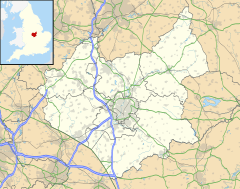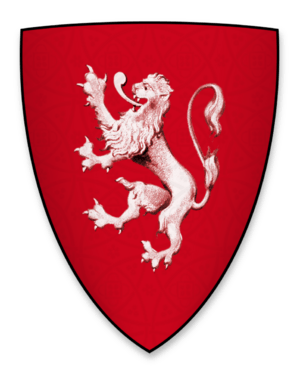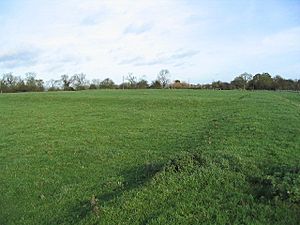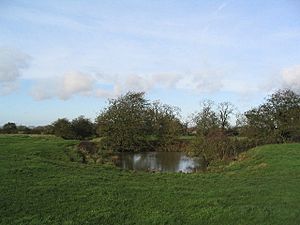Burton Lazars facts for kids
Quick facts for kids Burton Lazars |
|
|---|---|
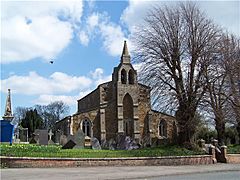 St James church, Burton Lazars |
|
| Population | 450 (2015 Estimate) |
| OS grid reference | SK7716 |
| • London | 146 kilometres (91 mi) SSE |
| Civil parish |
|
| District |
|
| Shire county | |
| Region | |
| Country | England |
| Sovereign state | United Kingdom |
| Post town | MELTON MOWBRAY |
| Postcode district | LE13-14 |
| Dialling code | 01664 |
| Police | Leicestershire |
| Fire | Leicestershire |
| Ambulance | East Midlands |
| EU Parliament | East Midlands |
| UK Parliament |
|
| Website | www.burtonlazars.com |
Burton Lazars is a small village in Leicestershire, England. It is located about 2 miles (3.2 km) south-east of Melton Mowbray. In 2015, about 450 people lived there.
Burton Lazars is famous for being the site of the main English base for the Order of Saint Lazarus. This was a special group of knights and helpers during the time of the Crusades.
Contents
Village History
The name 'Burton' means 'farm' or 'settlement'. The 'Lazars' part was added later. It comes from Saint Lazarus, who was linked to the Leprosy hospital built here.
Early Days
Burton was an Anglo-Saxon village long ago. It was called 'Burtone' in the Domesday Book of 1086. This book was a big survey ordered by William the Conqueror.
Before the Normans arrived, a noble named Leofric owned the village. After the Normans took over, Geoffrey of la Guerche became the owner. The village had meadows, two mills, and many people.
The Hospital's Influence
The village's name changed to Burton St Lazarus when the Order of Saint Lazarus opened a hospital for people with leprosy. This happened in the 12th century, during the Crusades. The hospital was built on a hill near the village.
This hospital became the main base for the Order in England. It collected a lot of money to help fund their work. This work included both military actions and caring for the sick in the Holy Land. Soon, the village's name became shorter, known as Burton Lazars.
Natural Spring and Later Years
Burton Lazars has a natural spring with sulfur in its water. This spring was probably why the hospital was built there. In 1760, someone tried to build a bath house to use the spring water. However, it did not become a successful business.
The churchyard in the village is the burial place of two famous racing drivers. They were Eliot Zborowski and his son Louis Zborowski.
In the early 1900s, the village was known for its steeplechase racecourse. This was a type of horse race with obstacles.
In 1866, Burton Lazars became its own parish. But on April 1, 1936, it joined with Dalby to form "Burton and Dalby" parish.
Hospital of Burton St Lazarus
This hospital was a very important place in medieval England. It was run by the Order of Saint Lazarus.
How it Started
The hospital at Burton Lazars was founded between 1135 and 1138. Many people across England likely helped pay for it. By 1146, it was doing well. It even started opening smaller branches in other parts of the country. This helped deal with leprosy, which soldiers and pilgrims brought back from the Crusades.
A very generous supporter was Roger de Mowbray. He was a Norman landowner who joined the Second Crusade. In 1150, he gave the Order a lot of land, a house, and two mills. His family continued to support the hospital for many years. The hospital even used his family's lion coat of arms.
The hospital was dedicated to the Virgin Mary and Saint Lazarus. It had a Master, eight brothers, and different numbers of lepers and injured knights. The brothers and sisters followed the Augustinian rule, which was a set of guidelines for their lives. They wore special clothes and would ask for donations. They had a meeting house, a burial ground, and were helped by priests and servants.
Many other important people also gave gifts to the hospital. These included Simon, Earl of Huntingdon, and William de Ferrers, 3rd Earl of Derby.
In 1180, King Henry II officially approved these gifts. He also gave the hospital money each year. Later Kings and Popes gave the hospital special rights. These included not having to pay royal or church taxes. They could also sell indulgences, which were special pardons, to raise money.
The hospital survived a big fire in the 1300s.
The Master's Role
The head of the hospital was called the "General Commander of the Order of St. Lazarus in England". This person was in charge of the hospital at Burton and all the Order's lands and hospitals across England. They only answered to the Master of the Order in Jerusalem. The Master of Burton Lazars traveled around the country. They visited other Lazarite houses to manage things and fix problems.
The Order's main goal was to protect and care for pilgrims and knights in the Holy Land. But in England, its main job was to raise money. The Master managed the Order's lands in England. They were often involved in arguments over land. Sometimes, they even used strong methods to get back what was owed to them.
There were also disagreements within the Order itself. One famous dispute was in 1364. Nicholas de Dover claimed to be the Master, even though Geoffrey de Chaddesden was already recognized. This led to arguments and even imprisonment. Eventually, they reached an agreement.
Another dispute happened in 1389. King Richard II tried to put his own people in charge of Burton Lazars. But the Order had already chosen Walter Lynton as its Master. This led to a fight over who controlled the hospitals. The King later admitted he was wrong and recognized Lynton as the rightful Master.
To prevent future problems, Lynton created a special book called the Cartulary of Burton St Lazars. This book carefully recorded all the Order's rights to its lands.
The Confraternity
The Fall of Acre in 1291 was a big event. It marked the end of the Crusades and pilgrimages to the Holy Land. Because of this, the role of the Order of St Lazarus changed. It became more of a confraternity. This was a group of people who joined together, often for religious reasons. Leprosy was also slowly disappearing in England.
Wealthy people who gave money to the Order became members. In return, the Order would pray for them and their families. Older relatives of members could also live at Burton in their retirement.
Many important people joined, like Lady Margaret Beaufort and King Henry VII. Even whole villages became members. The Order had agents who found new members far from Burton.
In 1422, the confraternity of Burton Lazars was given control of an older leprosy hospital in Lincoln.
Many seals belonging to the Confraternity of Burton St Lazarus have been found across England.
The End of the Hospital
The hospital managed to survive the first part of the Dissolution of the Monasteries. This was when King Henry VIII closed down many religious houses. But on May 4, 1544, the hospital was given to the Crown. At that time, it was valued at a good amount of money. This showed that Burton St Lazars was quite wealthy, more so than some other hospitals.
What Remains Today
The old hospital buildings are now buried underground. But you can still see signs of them today. There are earthworks (changes in the ground's shape) and ponds. In 1913, the Marquis of Granby started digging there. He found baking ovens and 100 clay tiles. Some of these tiles had the coats of arms of families who supported the hospital. The digging stopped because of war and was never finished.
Later, pictures taken from the air and studies on the ground helped people understand the site better. However, no more digging has been done to uncover more of its history.
Images for kids


